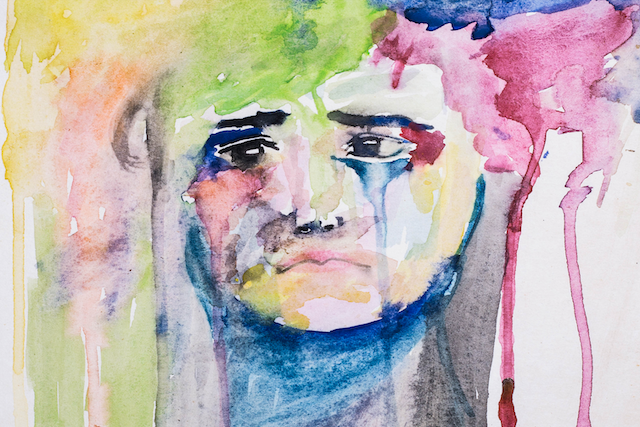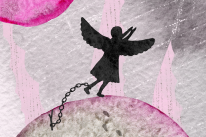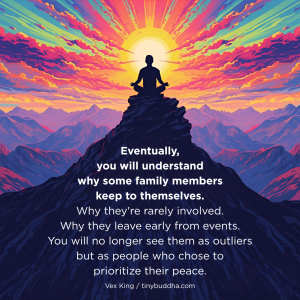
“Our sorrows and wounds are healed only when we touch them with compassion.” ~Buddha
When babies cry everyone rushes to find what’s wrong and alleviate their stress. It’s a bit of an instinct to do this in our culture.
We understand that the only way that a baby can communicate a need to us, whether it’s hunger, a necessary diaper change, fatigue, or discomfort, is to cry out. No one wants to hear a baby cry, so we respond quickly.
Unfortunately, as a child begins to grow and learns the language, we assume that they know how to communicate their needs effectively, yet do they?
As an elementary teacher I have come to know that even though children have more vocabulary words when they enter school, they still do not know how to communicate their needs. Often, children cry out to get their needs met, but all we see is defiance instead of their plea for help.
Bella is an adorable first grader who entered my classroom in September. I remember getting her kindergarten card, which noted that she could be a handful at times. I put the card in my filing cabinet at the start of the year because I like to get to know my kids from my own perspective without previous judgments.
When I met Bella and her mom at our welcome back picnic, I noticed that Bella appeared to be running the show. Her mom and I talked for a bit, and she shared that Bella’s dad died when she was only eight months old, and it was just the two of them still to this day. It was easy to see that mom was compensating for the loss.
Within the first month of school, I could certainly see why Bella had earned this reputation of being a handful. She could be a bit silly and somewhat defiant at times, but she knew the rules of our classroom and understood what kind of behavior was expected, so she did well with me.
Right after the December break, things started to change.
Bella was getting herself in trouble in art, music, and gym. She was not listening to directions and defying the teachers when they asked her not to do something. She was also talking back to adults in the building and getting herself into trouble at her before and after school program.
Her mom and I talked on the phone to create a plan of action. I suggested a behavior plan to help her, but asked mom to promise to follow through at home for this to be effective. The plan worked for only a few days because Bella just didn’t have a strong interest in following the rules.
On a Friday afternoon (likely around a full moon), Bella’s plea for help became apparent. She got in trouble from the moment she entered the school. She needed a great deal of redirection from me and found herself in trouble everywhere she went that day.
At lunchtime I got a phone call from the cafeteria asking if she was with me, because she took it upon herself to leave the cafeteria without permission. This put several staff members in a state of panic.
I walked down the hall and quickly found her.
We talked about her choices and why they were not safe. She apologized sweetly and assured me it wouldn’t happen again. The children returned to the room, and she asked to go to the bathroom. Five minutes later, she was brought to me by another teacher who caught her fooling around in the bathroom.
I was disappointed and caught up in the moment. I called her mom and asked her to meet me for an impromptu conference with Bella right after school.
My intent was to make an impact on her by having an immediate meeting with mom because she appeared to have no remorse. She was talking the talk by saying how sorry she was, but not choosing to walk the walk and something needed to be done.
A few hours later mom arrived at the school with tears in her eyes. She expressed her disappointment and shared concern that she was failing as a mother. She told me that she was terrified that Bella did not have a bond with her because she suffered from post partum after giving birth and felt that this was all her fault.
Bella was often in charge because mom was afraid to give her consequences, for fear that she would hate her. I reassured her that we would work through this together and come up with a plan.
When we entered the room, Bella ran up to her mom with a huge smile and jumped into her arms. This of course made her mother cry even more. She was most upset that her daughter didn’t have any remorse for her actions.
While we were having the meeting, Bella sat there stone faced with a bit of a smirk and she answered our questions like a trained professional. Her mom asked her why we were having the meeting and she stoically replied, “We are having this meeting because I’m not making good choices. I’m sorry, Mommy.”
I watched her and quickly noticed that she was not present. I looked into her eyes and said, “Bella, thank you for telling us what you know we want to hear, but what I’d really like to know is how you feel.”
I referred to my children’s book, The Light Inside of Me, because we use this frequently in our classroom to describe how we are feeling. I asked her if she felt that the light inside was bright or dim. She, of course, said it was dim.
I looked at her with loving eyes and said, “Bella, would you please put your hands on your heart and close your eyes, because I’d like to talk about your feelings.” She complied without hesitation. I then asked her to use an ‘I Statement’ to tell us why her light was dim.
She took a few minutes with her eyes closed, then opened them and looked directly at me. Her whole demeanor was different. She was softer, gentler, and certainly in the present moment.
She began to talk and tenderly said, “Well Mrs. Savini, my light is dim because I feel sad. I feel sad because I wish my life was different. I wish that one of my friends could live with me and my mom because I get lonely. I feel lonely Mrs. Savini, and that makes me really sad.”
I gave her a big hug, looked at her mom, and again told her that we would work this out together. Bella’s smile lit up the room because her inner light was beaming.
Our intent that day was to teach Bella a lesson. However, the true lesson was for the adults.
We learned that compassion was far more powerful than judgment. By opening our hearts to her plea for help, we gave her the opportunity to express what was really bothering her and heal the wounds developing on her heart.
We all have a child deep within that sometimes needs compassion and love.
I’m sure you can think of a person right now who is crying for help by acting out in some way. Perhaps the next time you encounter this person you could find it within your heart to see the child within and show compassion instead of judgment.
If they were an infant or even a crying child you would respond to their plea for help differently. See the child within yourself and others because a simple act of compassion can shift judgment to understanding and love. Choose love.
About Vicki Savini
Vicki Savini has been empowering children and adults through individual consultations and group workshops for over a decade. She is a Science of Mind Practitioner, Reiki energy worker, and talented intuitive guide. Join Vicki at the ICDI-Ignite San Jose conference on March 15th-16th where she will inspire and empower 9-12 year old girls to believe in themselves and speak their truth.http://www.hayhouse.com/event_details.php?event_id=1952.













 Though I run this site, it is not mine. It's ours. It's not about me. It's about us. Your stories and your wisdom are just as meaningful as mine.
Though I run this site, it is not mine. It's ours. It's not about me. It's about us. Your stories and your wisdom are just as meaningful as mine.
Wonderful post, Vicki. How does one deal with a sociopath, though? I have one (aged 52) in my family who has no remorse for lying to and cheating on his wife, and hurting his whole family. He says that his family deserves it. How do you reason with someone like that? Most importantly, how does one feel love and compassion for someone who’s made his wife and children suffer for 25 years? No matter how much you try to be loving and supportive, he refuses to stop.
Great wisdom Vicki – I will certainly try to help my children find the light within them, even when it dims, and see if I can extend that love and compassion to all the adults walking around with a hurt child inside them, including myself!
On the same page of compassion, do you know that there are people that deserve our compassion in Dharamsala? The Tibetan government and the Dalai Lama has declared a certain deity to be illegal, and with it people who practices this deity in dharamsala gets death threats, and have their homes wrecked and destroyed. Elsewhere on the net, Dalai Lama supporters attack and rebuke practitioners of this deity as if they deserve absolutely no compassion at all. And to add insult to the injury is that most of these people dont even know what they are hating anyway, they hate it just because the Dalai Lama says so. Didint the Buddha said always to investigate before believing in something?
Is it fair to treat people that dont agree with our religious standings this way?
Proof:
http://www.dorjeshugden.com/all-articles/the-controversy/tibetans-religious-freedom-the-true-face-of-tibetan-government-in-exile/
http://www.youtube.com/watch?v=nVIdXVxpBfQ
What a beautiful story – thank you for sharing it.
I don’t buy this. It feels like a defense for the writer to let everyone know how great she is and how much she should be respected by children and parents. The teary-eyed mom seems embellished. The real story is the mom is too tired working, being a single parent and the teacher can’t control the kids in her classroom. The mom has been willing to work with teachers in the past, but after a year of hearing the same diatribe, she no longer takes stock in what the educational system has to say. The mother needs compassion and support in order to give it to the child. At this point she will probably just say anything to get the teacher off her back (i.e. tripe about bonding problem), so she can go home do laundry, make dinner, worry about the funny sound her car is making and hope she can sleep well enough tonight in order to wake up and do it all again tomorrow.
Wow. This was awesome. thank you <3
Amazing story. Thanks for sharing.
Compassion is very powerful and an essential element of emotional intelligence.
I struggled with compassion for myself, in a non-narcissistic way… if that makes sense. In my case, I did not love self (through the way I was l living; addiction, depression, etc.) and after hitting a real bottom and doing some work (which is continuous by the way) did I learn what compassion for self is. And thus able to understand others better and be compassionate regardless of what their actions are.
Prayer helps a lot for me. Prayer for others whom I resent or feel anger towards. It helps remind me to have compassion and to bring only love to any situation. That in any given moment, we’re either giving or calling out for love.
This is such a beautiful story, Vicki, and kudos for the way you handled the situation. So many teachers and parents would respond with punishment, when children (and adults!) who act out are simply trying to get their needs met in the best way they know how.
It’s a really useful lesson to remember for the people around us and for ourselves too. Thanks so much for sharing!
Hi Vicki, so lovely to read your post – I also work with children and families (& couples) and have found that most wounds can be healed by offering the space and time to listen to feelings and share the truth .. Keep up the good work
That’s what I LOVE to hear Kathy…especially when you include yourself…put YOU at the top of that list! 🙂
Agreed! You too Joanna
It was an honor to share this story. 🙂
Beautifully said Jared! And you’re right, we must first learn to love ourselves. That is the key. When I have difficulties with someone I simply imagine them as a pure innocent baby…because we all started there…this helps me to remember that everyone has a beautiful light inside. Lots of Love, Vicki
You’re welcome. I am honored.
Again…it was an honor.
Everyone deserves our compassion.
The real question is…when will you love yourself first. Your husband is obviously hurting and has allowed his inner light to become incredibly dim, but you my dear are the keeper of your light. Other people don’t make us suffer, we choose to allow that. When you learn to love yourself and draw YOUR boundary lines he will no longer hurt you. He’s not trying to hurt you, he’s disconnected and hurting himself more than anyone. Consider loving yourself enough to let go of your pain and move to a higher vibration. If you would like some help with this, please email me; vicki@vickisavini.com
Vicki, important post. Now that compassion is going “mainstream” we need to engage in conversations about the beliefs we all hold about it. Some of those beliefs hold us back from allowing ourselves to feel empathy and compassion towards others. One common one is the belief we have that if we feel compassion towards others, we have to take certain actions. This is consistent with a common belief that feelings are “soft” and weaken us in some way against doing what we think is necessary. Part of this is the classic body-mind split.
While we are learning so much now from neuroscience and deeper examinations of human behavior and motivation, we still can’t fathom the depths of human experience or the impact of life’s experiences on others.
It’s common for the brain to go to extremes to try to understand others who are not like us. We cite Hitler and sociopaths (and unfortunately that term has been wrongly used to describe all kinds of behaviors we don’t fully understand) and pose dilemmas that few of us will have to actually deal with in the course of our lives.
To your point, there are many forms of acting-out behaviors that are in fact – a cry for help – or at the least, for compassion. What we choose to actually do about it, is another question, but let’s not let that block our hearts.
This is a wonderful article, Vicki. It’s a great reminder to us all, that when dealing with situations such as the one you described or to conflicts with friends or loved ones, we must not get caught up in our own feelings first, but rather consider what the other is feeling. Let that person say what he/she truly feels. Open your ears and heart, and truly listen to those feelings, then respond with compassion and empathy. If we do this, conflicts are resolved better. We also gain a better understanding of the other person.
Absolutely Jorge. Thank you for sharing 🙂
Beautifully said Louise
Vicki, what an amazing story – thank you for sharing it. Bella and her family (and the many others you have touched) are lucky to have you in their lives. So true if we can slow down enough to notice and see what is truly happening with people beyond what difficult behaviors show up on the surface, and interact with that… there is true transformation & possibility! Thanks for the post!
Hanna, thank you for your comments. It means the world to me! 🙂
“Compassion instead of judgment” – a powerful post. Thank you
Hands down the most touching and life-changing post on this site. Just when you think you know everything about Life, someone comes along to teach you something you wished you knew all along. Thank you Vicki.